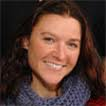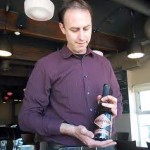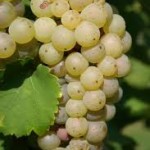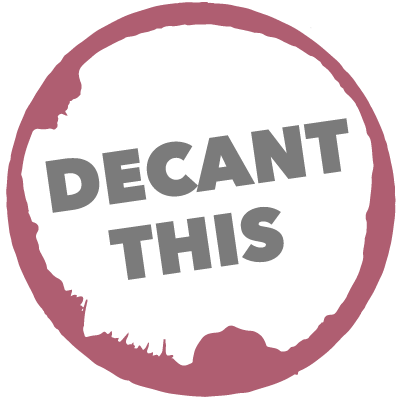Pinot Camp (sorta-kinda): Part I
Welcome to Pinot Camp.
Now of course this is not the real Pinot Camp, an annual confab in which Oregon wineries entertain and edify “the trade”: scores of wholesalers, retailers and restaurant folks. So this is as close as you (or I: the media is not invited) will get.
The Wine Company, a Minnesota distributor, hosted a daylong version of Pinot Camp with four gifted, passionate and engaging Willamette Valley vintners. The lowdown (with a little background):
Mark Vlossak, founder and winemaker at St. Innocent. “I started drinking when I was 7. I was a little bit hyperactive, and my mom said it would help me go to sleep.
 Mimi Casteel (left), general manager and viticulturist at Bethel Heights. “I got a Masters in Forest Ecology. And then I had a crazy love affair with this spot.
Mimi Casteel (left), general manager and viticulturist at Bethel Heights. “I got a Masters in Forest Ecology. And then I had a crazy love affair with this spot.
Andrew Davis, assistant winemaker at Argyle. “I went from cellar rat to winemaker in 8 years.
Jay Somers, co-owner and winemaker at J. Christopher Wines. “I liked Burgundy more than the New World, and then I realized I was in an area where they were making pinot noir.
Below are some of the highlights of the day. I have organized it by subject, and not chronologically, as they bounced around on various topics throughout this thoroughly enjoyable and educational day.
THE LAND
Casteel: “It’s the perfect storm of climate and geology so that producers can make these wines that can’t be made anywhere else. “¦In Oregon we are blessed to have everything in our soil that vines need, so we just have to make sure they can get to it. Our soil is ridiculously robust compared to Burgundy. “¦ The ideal is mid-elevation banks hooving up on these hills. The north-facing slopes are for timber and Christmas trees.
 Davis (left): “… Or sparkling wine [chuckles; sparklers are Argyle’s primary product]
Davis (left): “… Or sparkling wine [chuckles; sparklers are Argyle’s primary product]
Somers: “Being a bunch of crazy pinkos up in Oregon, we embrace that green thing “¦ We’re all in the vineyard. Our family, the kids and dogs are in that vineyard, so we want to take care of the land. Our friends and our workers are there. It needs to be a safe place to be.”
Casteel: “It’s for the most part wanting to live off the land, raise kids, like hippies. Oregon brings that out in people. Most everyone came and thought “˜I don’t wanna screw this up.’ So sustainability was important from the start.
Somers: “Our job is to shepherd, not to master.
THE VINEYARD
Vlossak: “You’ll have 3 acres that look completely alike, but the vines get very different treatment, and that’s before you take into account, erosion, weather, wind and water.
Casteel: “Pinot noir will go way down looking for water.
Somers: “[We have] the DRC (Deep Roots Coalition) for dry farming. Our philosophy: The vines want the water, and if you water slowly when they’re young, the vines will go find the water.
 Vlossak (left): “The key is managing a plant that has the capability of producing grapes, developing a canopy of leaves that captures the grapes and provide valued nutrition to ripen the fruit. So the two things are to build the vine and to ripen the fruit “¦ My biggest job is to be a leaf farmer, work on the canopy. When grapes start to ripen, you want [the vines] to stop growing leaves, to put all their energy into the grapes. “¦ Pinot noir and chardonnay love that dappled-sun effect.
Vlossak (left): “The key is managing a plant that has the capability of producing grapes, developing a canopy of leaves that captures the grapes and provide valued nutrition to ripen the fruit. So the two things are to build the vine and to ripen the fruit “¦ My biggest job is to be a leaf farmer, work on the canopy. When grapes start to ripen, you want [the vines] to stop growing leaves, to put all their energy into the grapes. “¦ Pinot noir and chardonnay love that dappled-sun effect.
Casteel: “In any given year, you drop 1/3 to ½ of your crop. You’re trying to get the canopy to a certain point and then stop.
Casteel: “These cold-climate grapes in particular are grown only with exactly what they need. If they have more than what they need, they lose expressiveness and tipicity. “¦ It’s much more important to have the right clones in a cold climate.
Vlossak: “When we got phylloxera, we just let it be, did only what we needed with the canopy and the grapes can have this wonderful swan song “¦
THE GRAPES
Somers: “Everyone thought I was completely nuts [making sauvignon blanc] in ’99. I was  thinking Sancerre. But the wine will express its own sense of place. This should be a little painful. We’re not making cocktail wine. “¦ We were planting four different major clones. It was the first major clonal experiment with sauvignon blanc in the United States. I really believe in this variety, and I’m really trying to emulate Sancerre. … If you don’t know the great white grapes of the world, you shouldn’t be making them.
thinking Sancerre. But the wine will express its own sense of place. This should be a little painful. We’re not making cocktail wine. “¦ We were planting four different major clones. It was the first major clonal experiment with sauvignon blanc in the United States. I really believe in this variety, and I’m really trying to emulate Sancerre. … If you don’t know the great white grapes of the world, you shouldn’t be making them.
Vlossak: “With chardonnay we basically bought a bunch of crap from California and then eventually tore it out. Adelsheim went and started the arduous process of bringing in Dijon clones. “¦ Chardonnay was our No. 1 crop for a while. In 2010, whites had 27 percent of the acreage and 38 percent of the production. “¦ Bright days allow the plant to make carbohydrates, but if the nights are warm, the plant eats its own acidity. In Oregon the nights are cold enough to actually shut down the plant. The cold nights give them backbone and acidity. “¦ Clean fresh acidity is the hallmark from Oregon. Our climate simply doesn’t let us do fat and buttery. Acidity in an Oregon chardonnay is a function of the terroir, not the winemaking.”
Davis: “We can get weight but not fatness, unctuousness but not that cloying kind.
Vlossak: “You can make pinot gris if you select the site. “¦ I don’t care what clone of pinot gris I’m planting; I just care how it’s grown. Which is a huge contrast to pinot noir clones. Textural richness is the key “¦ It’s the most texturally interesting of all the white grapes. This style has nothing to do with [Italian] pinot grigio “¦ Pinot gris is absolutely the best wine for salmon, and [the same holds true for] pinot blanc with shellfish, especially mussels.
 Davis: “For a long time we had wonderful riesling (left) and people said “˜let’s pull it up’ and then regretted it. We replanted a lot in Eola-Amity Hills. As far as I know, we’re the only ones to crop it like pinot, high-density, just enough room to squeeze between the plants. We find it falls between the German and Alsatian styles.
Davis: “For a long time we had wonderful riesling (left) and people said “˜let’s pull it up’ and then regretted it. We replanted a lot in Eola-Amity Hills. As far as I know, we’re the only ones to crop it like pinot, high-density, just enough room to squeeze between the plants. We find it falls between the German and Alsatian styles.
Casteel: “When you choose to grow riesling, it’s because you really want it and you’re never gonna make any money. It’s one of the real pains in the ass to grow. You don’t have late-season options like Germany and Alsace. It tends to be spicy. We do 20 percent barrel, 80 stainless, to get a uniformity on aging that ultimately will be beneficial to consumers.”
Next: Winemaking, vintages, heavy bottles and “global weirdness.”
3 Responses
Leave a Reply
You must be logged in to post a comment.




The lasting (and I think most valuable) impression I was left with after Pinot Camp is that Oregon is today what I envision California being 50+ years ago…all for one and one for all. While each winemaker has his/her own opinions on what matters most in making a particular wine, they all agree that what’s good for their neighbor is good for themselves and Oregon in general. Sharing of information is commonplace there, with a desire for the betterment of Oregon as a whole.
Their on to something, because so many of their Pinot Noirs are becoming favorites, at least in Minnesota!
I completely agree, Chris. That feeling pervaded the proceedings that day, and I felt the same thing when visiting Willamette last year.
Pingback : Pinot Camp (sorta-kinda), Part II | Decant This! … the wine blog of Bill Ward